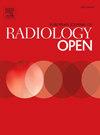Assessment of hemodynamic disturbances and impaired ventricular filling in asymptomatic fontan patients: A 4D flow CMR study
IF 1.8
Q3 RADIOLOGY, NUCLEAR MEDICINE & MEDICAL IMAGING
引用次数: 0
Abstract
Background
The Fontan procedure is a surgical intervention designed for patients with single ventricle physiology, wherein the systemic venous return is redirected into the pulmonary circulation, thereby facilitating passive pulmonary blood flow without the assistance of ventricular propulsion. Consequently, long-term follow-up of individuals who have undergone the asymptomatic Fontan procedure is essential.
Objectives
The aims of this investigation were to: 1) examine the impact of flow components and kinetic energy (KE) parameters on hemodynamic disturbances in asymptomatic Fontan patients and control group; 2) Assess left ventricular diastolic dysfunction through the analysis of 4D flow parameters across different Fontan sub-groups; 3) Compare intracardiac flow parameters among Fontan sub-groups based on morphological features of the left ventricle (LV) and right ventricle (RV).
Methods
Twenty-five Fontan patients (mean age: 10 ± 3 years, male/female: 15/10) and fourteen control subjects (mean age: 10 ± 2 years, male/female: 8/6) were recruited retrospectively for the study. The Fontan patients were further categorized into three groups based on their ventricular function: left ventricular (LV), right ventricular (RV), and biventricular (BiV). Each participant underwent cardiovascular magnetic resonance (CMR) imaging, including cine and 4D flow sequences on a 3.0 T scanner. Ventricular flow components and KE were assessed using 4D flow. The study utilized cine images to analyze cardiac function and inter-ventricular mechanical dyssynchrony. Echocardiography evaluated functional ventricular diastolic dysfunction.
Results
Fontan patients had a higher median functional single ventricle (FSV) residual volume compared to controls (28 % vs. 23 %, P = 0.034), with lower median FSV direct flow (32 % vs. 40 %, P = 0.005) and delayed ejection flow (17 % vs. 24 %, P = 0.024). The parameters of FSV normalized to the ventricular end-diastolic volume (KEiEDV) were found to be significantly lower in Fontan patients (all P < 0.05). In both left ventricle (LV) and biventricular (BiV) Fontan subgroups, direct flow was identified as an independent predictor of LV diastolic dysfunction (AUC=0.76, Sensitivity=86 %, Specificity=70 %). Furthermore, residual volume and E-wave KEiEDV were observed to be significantly different between LV and right ventricle (RV) Fontan subgroups.
Conclusions
The altered flow pattern and reduced kinetic energy observed in Fontan patients may indicate hemodynamic disturbances and compromised ventricular filling. Reduced direct flow is associated with LV diastolic dysfunction in LV and BiV Fontan subgroups. Systemic LV exhibited a more efficient intracardiac flow pattern compare with systemic RV in Fontan patients.
无症状fontan患者血流动力学紊乱和心室充盈受损的评估:4D血流CMR研究。
背景:Fontan手术是一种专为单心室生理患者设计的手术干预,其中全身静脉回流被重定向到肺循环,从而促进被动肺血流量,而无需心室推进的帮助。因此,对接受无症状Fontan手术的个体进行长期随访是必要的。目的:本研究的目的是:1)研究血流成分和动能(KE)参数对无症状Fontan患者和对照组血流动力学紊乱的影响;2)通过分析Fontan不同亚组的4D血流参数评估左室舒张功能障碍;3)根据左心室(LV)和右心室(RV)的形态学特征,比较Fontan亚组心内血流参数。方法:回顾性招募25例Fontan患者(平均年龄:10 ± 3岁,男/女:15/10)和14例对照组(平均年龄:10 ± 2岁,男/女:8/6)进行研究。Fontan患者根据心室功能进一步分为三组:左心室(LV)、右心室(RV)和双心室(BiV)。每位参与者都接受了心血管磁共振(CMR)成像,包括3.0 T扫描仪上的电影和4D血流序列。采用4D血流法评估心室血流成分和KE。该研究利用电影图像分析心功能和心室间机械非同步化。超声心动图评估功能性心室舒张功能不全。结果:Fontan患者有较高的平均功能性单心室(FSV)残余体积相比控制(28 %和23 % P = 0.034),较低的平均FSV直接流(32 %和40 % P = 0.005)和延迟喷射流(17 %与24 % P = 0.024)。FSV归一化到心室舒张末期容积(KEiEDV)的参数在Fontan患者中显著降低(所有P EDV在左心室和右心室(RV) Fontan亚组之间观察到显著差异。结论:Fontan患者血流模式改变和动能降低可能提示血流动力学紊乱和心室充盈受损。在左室和BiV Fontan亚组中,直接血流减少与左室舒张功能障碍有关。Fontan患者的全身性左室比全身性右室表现出更有效的心内血流模式。
本文章由计算机程序翻译,如有差异,请以英文原文为准。
求助全文
约1分钟内获得全文
求助全文
来源期刊

European Journal of Radiology Open
Medicine-Radiology, Nuclear Medicine and Imaging
CiteScore
4.10
自引率
5.00%
发文量
55
审稿时长
51 days
 求助内容:
求助内容: 应助结果提醒方式:
应助结果提醒方式:


